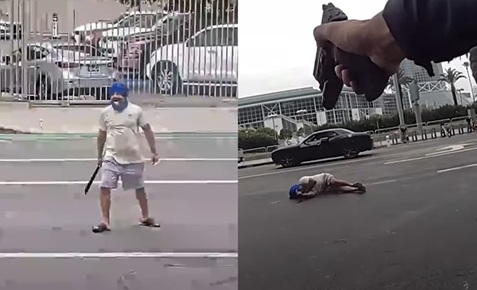| (Mains, General Studies Paper- 4: Ethics and Human Correlations: Essence of Ethics in Human Actions, Its Determinants and Consequences; Dimensions of Ethics; Ethics in Private and Public Relations) |
Context
On July 13, 2025, a 35-year-old Sikh man was shot dead by police in Los Angeles while he was demonstrating a traditional Sikh martial art called ‘Gatka’ at a city intersection. The incident has raised serious questions about police use of force and cultural misunderstanding.

About the Issue
- Bodycam footage released by the Los Angeles Police Department (LAPD) shows a Sikh man brandishing a two-foot-long sword, which police described as a machete but some sources described it as a Khanda sword used in Gatka.
- After reportedly ignoring multiple emergency calls and police warnings, the officers opened fire, killing the man in hospital.
Ethical Perspective
- Several questions arise from an ethical perspective. Was the police's use of lethal force justified? Did cultural ignorance lead to this tragedy?
- Ethics evaluates any action based on its intention, consequences, and circumstances.
- In this case, the police's intention was to ensure public safety, but it resulted in a man's death. This raises the question of whether the action was fully justified.
The issue of use of brutal force in such circumstances
- The police's argument is that the Sikh man brandishing a sword and running toward the police was a threat to public safety.
- Morally, the primary duty of the police is to protect society. If a person displays aggressive behavior with a weapon, the police have to make a quick decision.
- However, the question arises whether lethal force was the only option, especially when the person's behavior initially appeared to be a Gatka performance.
Could other options have been used ?
- Morally, the police should have used Tasers, beanbag rounds, or rubber bullets as non-lethal options. These devices could have been effective in controlling the person without killing him.
- Also, involving mental health experts could have been a better strategy as some reports described the Sikh man's behavior as erratic.
- Lack of cultural training may also have been a factor as Gatka is a religious and cultural performance, which the police misunderstood.
Legal Approach in US and India
- Law in US: Police in US are allowed to use deadly force when they believe their lives or the lives of others are in immediate danger. According to the US Supreme Court case ‘Graham v. Connor (1989), the use of force must be ‘reasonable’ depending on the severity of the situation. In this case, the police department saw the aggressive behaviour of the man and the sword as a threat.
- Law in India: Section 46 of the Code of Criminal Procedure (CrPC) in India allows police to use force but deadly force can be used only if the person is committing a grievous offence or posing a life-threatening threat. Indian police are encouraged to use non-lethal weapons and emphasis is laid on cultural sensitivity.
Is it morally justifiable
- Based on principles of morality, such as non-violence and the sanctity of human life, the use of lethal force should be a last resort. If the perpetrator was in a mental health crisis, their death is a tragic outcome.
- Cultural ignorance and ignorance of non-lethal options made this incident more complex. Morally, the police should have shown more patience and sensitivity in such situations.
About Gatka
- Gatka is a traditional Sikh martial art that originated in Punjab.
- It is performed during Sikh religious and cultural events, such as Baisakhi and Gurpurab.
- It uses weapons such as sword, khanda, lathi and shield. Gatka aims to promote self-defense and Sikh values, such as courage and honor. It is a disciplined and controlled art that is performed.
Challenges for society
- Cultural misunderstanding: The incident reflects ignorance about Sikh culture and traditional performances such as Gatka. This can lead to mistrust and fear among minority communities.
- Tension between police and community: The use of lethal force by police can increase mistrust of police among minority communities (especially the Sikh community).
- Mental health crisis: If the person was suffering from mental health problems, the incident highlights the police's inadequate preparedness to handle mental health crises.
- Impact on social cohesion: Such incidents can undermine social cohesion and increase feelings of discrimination on racial or religious grounds.
Future Outlook
- Cultural training: Police should undergo cultural sensitivity training so that they can understand cultural performances like Gatka and avoid misunderstandings.
- Use of non-lethal weapons: Police should increase the use of non-lethal weapons like Tasers, rubber bullets and beanbag rounds to avoid fatal consequences.
- Mental health intervention: Mental health experts should be involved in emergency calls, especially when behaviour appears unruly.
- Community interaction: Police should conduct regular dialogues and trust-building programmes with minority communities.
- Transparent investigation: Such incidents should be investigated impartially and transparently to maintain public confidence.
Conclusion
This incident underlines the need for police training, cultural awareness and mental health intervention. From an ethical perspective, protecting human life should be the top priority. Such tragedies can be prevented in the future by focusing on cultural sensitivity and non-lethal measures. This will be a step towards making society more inclusive and sensitive.



